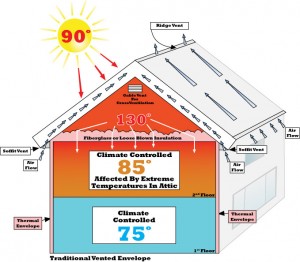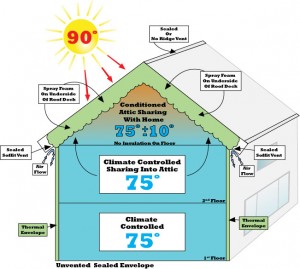Applications
Traditional Vented Envelope

This “traditional envelope” diagram is showing a ventilated roof with insulation on the attic floor (ceiling line.) The second floor of the house cannot compete with the sun-bombarded attic in extreme temperatures, making it much warmer than the first floor. The thermal envelope established at the attic floor is poorly defined by a product which does not air-seal, and is not strong enough to stop the superheated attic air from infiltrating the house. This causes significant discomfort for the household members and crippling electric bills. If the floor is insulated below the joist level, then it is not done to PA code and you are likely heating and cooling your neighborhood out of the roof. If it is done to code (R-38), then you are eliminating any chance of using your attic for storage; as it will exceed joist level by 8″-10″, while yielding the same poor results.
Unvented Sealed Envelope

This “sealed envelope” diagram shows the thermal envelope correctly moved from the attic floor to the outermost perimeter of the house. Spray foam is applied to the roof deck, sealing all areas that allow air from outside to penetrate the attic. The attic is now a semi-conditioned space that shares much lower temps with your house, rather than with the outside. This will cut utility bills and distribute the temperature in the house much more evenly. The house is now more comfortable, and the attic can subsequently be used for storage and efficient hosting of HVAC equipment.
